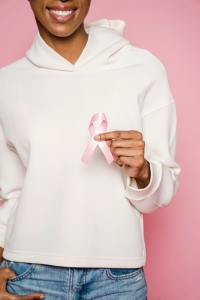Debbie Archer | School of Agriculture, Fisheries and Human Sciences

October is Breast Cancer Awareness month. It is a time when an annual national campaign promoting regular screening and early detection of breast cancer occurs, Teresa Henson, Extension specialist-program outreach coordinator for the University of Arkansas at Pine Bluff’s School of Agriculture, Fisheries and Human Sciences, said. According to the National Breast Cancer Foundation, one in eight women will develop breast cancer in their lifetime.
The Centers for Disease Control and Prevention (CDC) states that more than 260,000 women are diagnosed with breast cancer each year, and about 42,000 will die from the disease in the United States. Men also get breast cancer, but it is not very common. About one out of every 100 breast cancers diagnosed in the United States is found in a man. Most breast cancers are found in women 50 years or older, but breast cancer also affects younger women.
“Early detection is the key,” Henson said, “and understanding what breast cancer is, your chances of getting it and how to find it early is vital.”
The CDC offers the following information about breast cancer:
What is breast cancer?
Breast cancer is the second most common cancer among women, after skin cancer. It is a disease in which cells in the breast grow out of control. Cancer cells can also spread, or metastasize, to other parts of the body.
What are the symptoms of breast cancer?
There are different symptoms of breast cancer, and some people have no symptoms at all. Symptoms can include:
-Any change in the size or shape of the breast.
-Pain in any area of the breast.
-Nipple discharge other than breast milk (including blood).
-A new lump in the breast or underarm.
These symptoms can happen with other conditions that are not cancer. If you have any signs that concern you, immediately see your healthcare provider.
What can I do to find breast cancer early?
Breast cancer screening involves checking a woman’s breasts for cancer before there are signs or symptoms of the disease. A mammogram is an X-ray picture of the breast. Doctors use a mammogram to look for early signs of breast cancer. The United States Preventive Services Task Force (USPSTF) recommends that most women who are at average risk and are 50 to 74 years old get one every two years.
USPSTF recommends that women with a parent, sibling or child with breast cancer are at a higher risk for breast cancer and may benefit from beginning screening in their 40s. Weighing the benefits and risks of screening is essential when considering your screening options. If you’re 40 to 49 years old, talk to your healthcare provider about when to start screening.
When should you get a mammogram?
Ask your doctor when you should get a mammogram. Mammograms are the best way to find breast cancer early when it is easier to treat and before it is big enough to feel or cause symptoms.
How to reduce your breast cancer risk?
You can do several things to help lower your breast cancer risk:
-Keep a healthy weight and exercise regularly.
-Choose not to drink alcohol or drink alcohol in moderation.
-If you are taking hormone replacement therapy or birth control pills, ask your doctor about the risks.
-Breastfeed your children, if possible.
“If you are worried about the cost of a mammogram, the CDC’s National Breast and Cervical Cancer Early Detection Program offers free or low-cost mammograms to women who have low incomes and are uninsured or underinsured,” Henson said. “Find out if you qualify at www.cdc.gov/cancer/nbccedp/.”
Henson stresses that early detection of breast cancer is critical because it is easier to treat when it is found sooner rather than later.
The University of Arkansas at Pine Bluff offers all its Extension and Research programs and services without regard to race, color, sex, gender identity, sexual orientation, national origin, religion, age, disability, marital or veteran status, genetic information, or any other legally protected status, and is an Affirmative Action/Equal Opportunity Employer.


Pingback: October is Breast Most cancers Consciousness Month | Breast Cancers